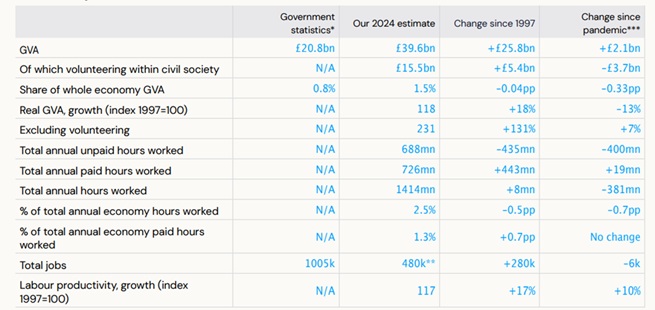Civil society and volunteering are widely recognised as important generators of social value. From food banks to cancer research, local sports teams or youth clubs, it’s clear that civil society provides vital services, makes our communities stronger and boosts our wellbeing.
But civil society is rarely recognised for its economic contribution. This is a missed opportunity.
In the most direct sense, official statistics undervalue the activity of civil society by excluding the value of volunteering from measures of economic activity (as international guidelines dictate). But doing so means that official statistics exclude a massive contribution to the UK economy – around 688 million volunteer labour hours in 2024.
When we adjust how the economic contribution of civil society is measured and include the value of volunteer labour, we find its actual contribution is almost double the official measure – shifting from 0.8% of the economy’s Gross Value Added (GVA) in official statistics to 1.5% in our adjusted measurement, nearly £40bn. This puts civil society’s economic contribution in line with the agriculture and car manufacturing industries combined.
Even with our conceptual adjustments, the figures in this paper underestimate the economic contribution of civil society. This is due to the difficulty in identifying non-profits organisations in national accounts data. Without a civil society satellite account, which captures non-profits across all sectors, we will never know the full extent of civil society’s economic contribution in the UK. International comparisons suggest the underestimate could be substantial. In the 16 countries worldwide that have created their own satellite accounts, civil society and volunteering was found to make up between 1.6% and 8.1% of GDP.
The adjustments above would give us a much clearer picture of the direct economic contribution of civil society. However, by ignoring the manifold spillover benefits associated with civil society’s activity, even this underestimates its overall economic impact. Civil society organisations boost people’s educational outcomes, skills, physical and mental health, and financial resilience, among other things. Participation in volunteering provides opportunities to develop skills and gain experience, which can help people into work and supports higher levels of productivity for those already in work. As a result, individuals are better able to participate in the labour market, pay taxes and reduce their reliance on public services, all of which increase labour supply, reduce fiscal pressures and contribute to wider economic growth.
By underestimating civil society’s economic contribution, the Government risks underestimating the economic damage of failing to address the sector’s challenges. Much of the sector is under financial pressure, with organisations often pushed into unhelpful competition and shorttermism, all of which holds back productivity. Meanwhile, the decline of volunteering rates in England following the pandemic has created a significant drag on civil society’s growth. We estimate that declining volunteering rates have created a £38.5bn gap over the past five years (based on falling volunteer labour hours), even before factoring in the value of missed spillover benefits.
Supported with strategic investment, civil society has the potential to be a driver of future growth. As both a direct economic force, responsible for 2.5% of overall UK labour hours in 2024, and as a creator of wider economic value, civil society’s economic footprint is significant.
The government needs to look beyond current official statistics to recognise the true extent of civil society’s economic contribution. Doing so is a necessary first step to ensure civil society receives the attention it deserves to fulfil both its social and economic potential.
Table: Summary of the economic contribution of civil society in 2024: government estimates and our adjusted estimates

*Government statistics are calculated following international guidance on producing national accounts data.
**Our estimate for this figure is for 2023.
***Since 2019


